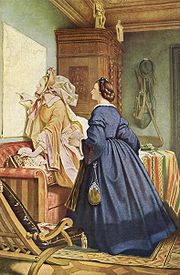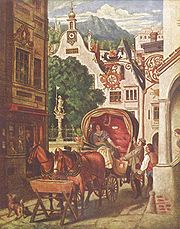
Moritz von Schwind
Encyclopedia



Austria
Austria , officially the Republic of Austria , is a landlocked country of roughly 8.4 million people in Central Europe. It is bordered by the Czech Republic and Germany to the north, Slovakia and Hungary to the east, Slovenia and Italy to the south, and Switzerland and Liechtenstein to the...
n painter, born in Vienna
Vienna
Vienna is the capital and largest city of the Republic of Austria and one of the nine states of Austria. Vienna is Austria's primary city, with a population of about 1.723 million , and is by far the largest city in Austria, as well as its cultural, economic, and political centre...
.
Moritz von Schwind received rudimentary training and spent a happy and carefree youth in Vienna. Among his companions was the composer Schubert
Franz Schubert
Franz Peter Schubert was an Austrian composer.Although he died at an early age, Schubert was tremendously prolific. He wrote some 600 Lieder, nine symphonies , liturgical music, operas, some incidental music, and a large body of chamber and solo piano music...
, some of whose songs he illustrated. In 1828, the year of Schubert's death, he moved to Munich
Munich
Munich The city's motto is "" . Before 2006, it was "Weltstadt mit Herz" . Its native name, , is derived from the Old High German Munichen, meaning "by the monks' place". The city's name derives from the monks of the Benedictine order who founded the city; hence the monk depicted on the city's coat...
, where he befriended the painter Schnorr and enjoyed the guidance of Cornelius
Peter von Cornelius
Peter von Cornelius was a German painter.Cornelius was born in Düsseldorf.His father, who was inspector of the Düsseldorf gallery, died in 1799, and the young Cornelius was stimulated to extraordinary exertions...
, then director of the Academy.
In 1834 he was commissioned to decorate King Ludwig
Ludwig I of Bavaria
Ludwig I was a German king of Bavaria from 1825 until the 1848 revolutions in the German states.-Crown prince:...
's new palace with wall paintings illustrating the works of the poet Tieck. He also found in the same place congenial sport for his fancy in a "Kinderfries". He was often busy working on almanacs, and on illustrating Goethe and other writers through which he gained considerable recognition and employment.
In the revival of art in Germany, Schwind held as his own the sphere of poetic fancy. In 1839 he was entrusted with the new Karlsruhe academy, itself an embodiment in fresco of ideas thrown out by Goethe. He decorated a villa in Leipzig with the story of Cupid and Psyche
Cupid and Psyche
Cupid and Psyche , is a legend that first appeared as a digressionary story told by an old woman in Lucius Apuleius' novel, The Golden Ass, written in the 2nd century CE. Apuleius likely used an earlier tale as the basis for his story, modifying it to suit the thematic needs of his novel.It has...
, and further justified his title of poet-painter with designs from the Niebelungenlied and Tasso
Torquato Tasso
Torquato Tasso was an Italian poet of the 16th century, best known for his poem La Gerusalemme liberata , in which he depicts a highly imaginative version of the combats between Christians and Muslims at the end of the First Crusade, during the siege of Jerusalem...
's Gerusalemme for the walls of the castle of Hohenschwangau in Bavarian Tirol.
From the year 1844 dates his residence in Frankfurt during which he created some of his finest easel pictures, most notably the "Singers' Contest" in the Wartburg
Wartburg Castle
The Wartburg is a castle situated on a 1230-foot precipice to the southwest of, and overlooking the town of Eisenach, in the state of Thuringia, Germany...
(1846), as well as designs for the Goethe celebration. There were also numerous book illustrations. The conceptions for the most part are better than the execution.
In 1847 Schwind returned to Munich on being appointed professor in the academy. Eight years later his fame was at its height on the completion in the castle of the Wartburg of wall pictures illustrative of the "Singers' Contest" and of the history of Elizabeth of Hungary. The compositions received universal praise, and at a grand musical festival in their honour, Schwind himself was one of the violinists.
In Munich he also worked on some churches, particularly the altar and windows of the Church of Our Lady.
His exceptionally mature cycle, "Seven Ravens" from Grimm
Brothers Grimm
The Brothers Grimm , Jacob Grimm and Wilhelm Grimm , were German academics, linguists, cultural researchers, and authors who collected folklore and published several collections of it as Grimm's Fairy Tales, which became very popular...
's fairy stories was produced in 1857. In the same year he visited England to report officially to King Ludwig on the Manchester art treasures. So diversified were his gifts that he turned his hand to church windows and joined his old friend Schnorr in designs for the painted glass in Glasgow Cathedral
Glasgow Cathedral
The church commonly known as Glasgow Cathedral is the Church of Scotland High Kirk of Glasgow otherwise known as St. Mungo's Cathedral.The other cathedrals in Glasgow are:* The Catholic Metropolitan Cathedral Church of Saint Andrew...
.
Towards the close of his career, with broken health and his powers on the wane, he revisited Vienna. During this time, he created the cycle from the legend of Melusine
Melusine
Melusine is a figure of European legends and folklore, a feminine spirit of fresh waters in sacred springs and rivers.She is usually depicted as a woman who is a serpent or fish from the waist down...
and the designs commemorative of chief musicians which decorate the foyer of the Vienna State Opera
Vienna State Opera
The Vienna State Opera is an opera house – and opera company – with a history dating back to the mid-19th century. It is located in the centre of Vienna, Austria. It was originally called the Vienna Court Opera . In 1920, with the replacement of the Habsburg Monarchy by the First Austrian...
. Cornelius writes, "You have translated the joy of music into pictorial art."
Schwind's genius was lyrical - he drew inspiration from chivalry
Chivalry
Chivalry is a term related to the medieval institution of knighthood which has an aristocratic military origin of individual training and service to others. Chivalry was also the term used to refer to a group of mounted men-at-arms as well as to martial valour...
, folk-lore
Folk-Lore
Folk-Lore was released in 2002 by Celtic metal band Cruachan.-Track listing:#"Bloody Sunday" – 4:15#"The Victory Reel" – 1:21#"Death of a Gael" – 5:38#"The Rocky Road to Dublin" – 3:07#"Ossian's Return" – 4:44...
, and the songs of the people. Schwind died in Pöcking
Pöcking
Pöcking is a municipality in the district of Starnberg in Bavaria in Germany. Duchess Elisabeth in Bavaria, consort of Emperor Franz Josef I of Austria-Hungary, grew up here in the Possenhofen Castle as daughter of Duke Max in Bavaria and Princess Ludovika of Bavaria. Otto von Habsburg, Crown...
in Bavaria, and was buried in the Alter Südfriedhof
Alter Südfriedhof
The Alter Südfriedhof is a cemetery in Munich, Germany. It was founded by Duke Albrecht V as a plague cemetery in 1563 about half a kilometer south of the Sendlinger Gate between Thalkirchner and Pestalozzistraße.-History:...
in Munich.

